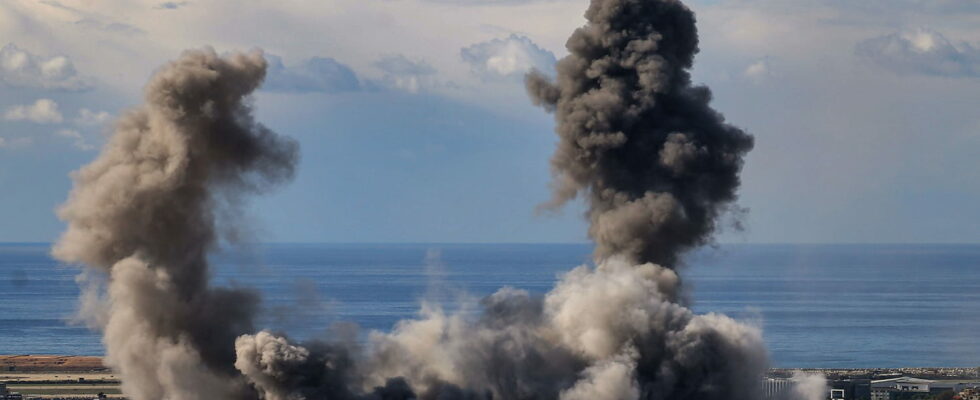After more than a year of war, including two months of escalation, between Israel and Lebanese Hezbollah, the Hebrew state approved a ceasefire agreement on Tuesday evening. The truce will begin on the night of Tuesday to Wednesday.
Ten votes to one. Israel approved a ceasefire agreement with Lebanese Hezbollah on Tuesday evening. The Israeli Prime Minister announced the presentation of this agreement for approval to the security cabinet earlier in the evening. “The duration of the ceasefire will depend on what happens in Lebanon,” Benjamin Netanyahu immediately clarified. In his speech on Israeli television, the Prime Minister was keen to emphasize that “in complete agreement with the United States, we maintain total freedom of military action” in Lebanon, specifying that in the event that Hezbollah comes to violate the agreement and/or attempt to rearm “we will attack”. The truce must begin on the night of Tuesday to Wednesday, at 4 a.m. local time, or 3 a.m. in Paris.
In a joint statement, France and the United States indicated that they will particularly ensure that the ceasefire is “implemented in its entirety”. From Wednesday, the former Minister of Foreign Affairs, Jean-Yves Le Drian, will travel to Lebanon as the personal representative of Emmanuel Macron. The French head of state, for his part, welcomed this ceasefire agreement on Tuesday evening while calling for the election of a new Lebanese president. “The restoration of Lebanon’s sovereignty requires the immediate election of a President of the Republic capable of uniting the Lebanese through the formation of a strong and representative government and the adoption of the reforms necessary for recovery. […] of the country”, he judged. For her part, the President of the European Commission, Ursula von der Leyen, welcomed in the wake of the announcement “very encouraging news”.
While the Israeli Minister of National Security, Itamar Ben-Gvir, strongly opposed the truce in recent hours, believing that concluding an agreement with Lebanon would be “a serious error” and a “missed historic opportunity to eradicate Hezbollah”, Benjamin Netanyahu defended the ceasefire agreement in Lebanon on Tuesday evening. For the Prime Minister, this will allow the Jewish state to “focus on the Iranian threat”, but also to “rearm” its troops and “intensify pressure on Hamas”. For his part, the Lebanese Prime Minister called, in a press release, “the international community […] to act quickly to put an end to this aggression and immediately implement a ceasefire.”
What does the ceasefire agreement between Israel and Hezbollah include?
On Tuesday evening, Benjamin Netanyahu did not specify what exactly the ceasefire agreement provided. However, several points were mentioned in the media in recent hours, such as the fact that he would impose measures comparable to Israeli forces and those of Lebanese Hezbollah, a pro-Iranian Shiite Islamist group. It would also aim to evacuate the area of southern Lebanon where the clashes are concentrated. The text would provide for a 60-day truce during which the two belligerents would put an end to their armed presence: the Israeli army should leave Lebanon and Hezbollah should retreat north of the Litani River according to the American information site Axios.
The departure of these troops would give way to the arrival of thousands of soldiers from the Lebanese army which has remained away from the conflict, except for a few strikes in retaliation for Israeli attacks targeting its infrastructure. At least 5,000 soldiers could be mobilized according to Lebanese Foreign Minister Abdallah Bou Habib, reports France 24. The Lebanese army would be supported by the Blue Helmets, the UN peacekeeping force.
To ensure compliance with the terms of the ceasefire – which partly echoes those of UN Security Council Resolution 1701, adopted in 2006 after a month-long war between Israel and Lebanon, but never fully respected – an international monitoring committee would be set up. Five countries should make up this committee led by the United States.
Conditions still pending, others abandoned
If the broad outlines of the agreement appear acceptable to both parties according to the international community, a few conditions complicated the negotiations. On the question of the international monitoring committee, the choice of member countries was debated: Israel opposed France’s presence due to Franco-Lebanese political relations and the disagreements and heated exchanges between Emmanuel Macron and Benyamin Netanyahu. The Hebrew State would have finally revised its position accepting the presence of France. On the other hand, Hezbollah refused Britain’s participation for its proximity to Israel. Will he concede on this point after the Israeli concession?
However, Israel has put forward another demand: that of having the freedom to strike Lebanon in the event of violation of the terms of the agreement by the Islamist group. A point defended by Israeli Defense Minister Israel Katz in the name of a “zero tolerance policy”, but which seems hardly compatible with a ceasefire agreement and which would result in a violation of Lebanon’s sovereignty. The leader of Hezbollah clarified for his part that he would only accept an agreement on the condition that it involves a “complete end to aggression”.
Another point could remain a source of tension without being able to be resolved by the terms of the ceasefire agreement: the 13 contested points of the blue line, the border between Israel and Lebanon. The blue line was drawn by the UN in 2000 after the Israeli withdrawal from Lebanon, but thirteen points on this border are disputed between the two countries. Israel and Lebanon, however, refuse to negotiate on the distribution of land.
